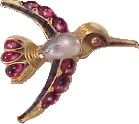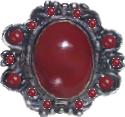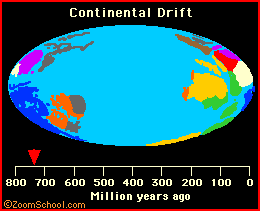
 |
| Our subscribers' grade-level estimate for this page: 4th - 5th |
 |
Rock and Mineral Dictionary |
 |
| A | B | C | D | E | F | G | H | I | J | K | L | M | N | O | P | Q | R | S | T | U | V | W | X | Y | Z |
 cabochon A cabochon is a stone that has a rounded, domed surface with no facets. A cabochon garnet is also called a carbuncle. |
Cairngorm Cairngorm is a yellow-brown type of smoky quartz that is often used in traditional Celtic jewelry. Cairngorm is not Scottish topaz. The supply of cairngorm is virtually exhausted, so heat-treated Brazilian amethyst is used as a substitute in Scottish jewelry. |
calcite Calcite (Calcium Carbonate, CaCO3) is a very common mineral that comes in a wide variety of forms, shapes and colors. The trigonal crystals range from translucent to transparent. Transparent calcite exhibits a double refraction effect (when you look through the crystal, singel items are doubled). Calcite has a hardness of 3 (most forms), a specific gravity of about 2.7, a refractive index of 1.49 and 1.66, and a white streak. |
caldera A caldera is a large depression formed from a collapsed volcano. Calderas are often circular or elliptical. |
California ruby A California ruby is actually a pyrope garnet (and not a ruby at all). |
calsilica Rainbow calsilica is a newly-found, multi-colored, layered stone composed of calcium and silica. This stone has been recently used for Zuni fetish carvings and in some jewelry (beads and cabochon cut stones). Rainbow calsilica was only recently found in Mexico or Northern South America (it's origin remains mysterious). Some people theorize that this stone formed as a result of the runoff of mining or oil-drilling chemicals, and has only formed in the last 30 to 50 years (but this is uncertain). |
Canary diamond Canary diamonds are diamonds that have a deep yellow color. Diamonds are precious, lustrous gemstones made of highly-compressed carbon; they are one of the hardest materials known. Diamonds have a hardness of 10, a specific gravity of 3.5, and a refractive index of 2.417 - 2.419. |
canyon A canyon is a deep valley with very steep sides - often carved from the Earth by a river. |
Cape amethyst Cape amethyst is a form of amethyst that is layered or striped with milky quartz. Cape amethyst is a translucent gemstone that ranges from light- to medium-purple and has white bands. |
Cape ruby A Cape ruby is actually a pyrope garnet (and not a ruby at all). |
carat A carat (ct.) is a standard measure of weight used for gemstones. One carat weighs 0.2 gram (1/5 of a gram or 0.0007 ounce). A hundredth of a carat is called a point. The carat unit was introduced in 1907. |
carbonardo A carbonardo is a rare type of opaque black diamond; they are not used for jewels, but for items like drilling bits and abrasive wheels. They were once thought to have been formed as a result of a comet impact 2 billion years ago, but this is no longer thought to be true. The largest diamond ever found was a carbonardo that weighed over half a kilogram. Carbonadoes are found in Bahia, Brazil, South America. Unlike other diamonds, carbonadoes are not found in a crystallized form - they are found in irregular or rounded fragments. Carbonadoes have a hardness of 10 and a specific gravity (density) of 3.1-3.3. Diamonds have a very hard polycrystalline carbon structure. |
carbuncle A carbuncle is a cabochon-cut garnet. |
 carnelian Carnelian (also called cornelian and carneole) is a reddish form of chalcedony (a type of quartz). This translucent stone has a waxy luster. The best carnelian is from India. Most commercial carnelian is really stained chalcedony. Carnelian has a hardness of 7 and a specific gravity of 2.61. |
cat's eye chrysoberyl Cat's eye (chatoyant chrysoberyl) is a yellow to green-yellow to gray-green stone with a bright, pupil-like slit that seems to move slightly as the stone is moved. Most Cat's eye is cut as cabochons to maximize the distinctive pupil-like effect. Most cat's eye chrysoberyl is found in Brazil. Cat's eye chrysoberyl has a hardness of 8.5. This stone is sometimes enhanced by irradiation (this process improves the color and accentuates the stone's asterism). |
cave A cave is a large hole in the ground or in the side of a hill or mountain. |
Cenozoic era The "Age of Mammals" (65 million years ago - today), saw the emergence of familiar life forms, humans, the modern look of the continents, and a cooling climate. The Cenozoic followed the Mesozoic Era. |
chalcedony Chalcedony is a family of minerals (microcrystalline quartz) that are often milky to gray to bluish in color. Chalcedony includes agate, carnelian (waxy red), chalcedony (blue), chrysoprase (green), onyx (black and white), bloodstone, sard (brownish-red), jasper (hornstone), seftonite, and others. Chalcedony is porous and translucent. Chalcedony has a hardness of 6.5-7 and a specific gravity of 2.6. |
champagne diamond A champagne diamond is a pinkish brown diamond (having a color of C2-C3). Most champagne diamonds are mined in Western Australia (in the Argyle Mine). The color is produced by a their low nitrogen content. |
charoite Charoite is a very rare, bright purple mineral used as a gemstone. This silicate is only found in Russia (at the Chary River at Aldan). Charoite is transparent to translucent and has a hardness of 5. |
Chatham synthetic ruby Chatham synthetic rubies (laboratory-created rubies) were introduced by Carroll Chatham in 1959. |
 chatoyancy Chatoyancy is the lustrous, cat's eye effect seen in some cabochon stones, like cat's eye, tiger's eye (pictured above), and sometimes in other stones, like aquamarine. In chatoyancy, light is reflected in thin bands within the stone. Chatoyant stones are cut in cabochon to maximize the lustrous effect. |
chert Chert is a hard, dense, fine-grained type of sedimentary rock, a crystalline aggregate of silica (quartz). It was formed from deposits of silica-based skeletons of microscopic marine organisms (including zooplankton like diatoms, radiolarians, plus sponge spicules and other organic matter). Black chert is called flint. |
Chinese opal Chinese opal is a misnomer for pearl opal (a type of organic opal), moonstone, or white chalcedony. |
C Horizon Also called regolith: the layer beneath the B Horizon and above the R Horizon. It consists of slightly broken-up bedrock. Plant roots do not penetrate into this layer; very little organic material is found in this layer. |
Chrome diopside Chrome diopside is an emerald-green colored gemstone. It is a chromium-rich variety of the common mineral diopside (Calcium magnesium silicate). Chrome diopside has a hardness of 5 to 6 and a specific gravity of 3.3 to 3.6. |
chrysoberyl Chrysoberyl is a hard stone that ranges in color from yellow, to brown, to green. Some chrysoberyls include alexandrite and cat's eye. |
chrysocolla Chrysocolla (meaning "golden lime" in Greek) is an opaque blue to blue-green mineral sometimes used in jewelry. It is usually cut as a cabochon. Chrysocolla (hydrated copper silicate) is found embedded in rock crystal in copper mines in the USA, Russia, Chile, and the Congo. Although Chrysocolla has been used in ornaments since the time of the ancient Greeks, it was only described mineralogically in 1968. Its hardness varies from 2 to 4. |
 chrysolite Chrysolite is a name used for many stones. During Victorian and Edwardian time, it referred to green-yellow chrysoberyl. It can also refer to peridot (shown above). Long ago, the name was used to refer to almost any yellowish gem. |
chrysoprase Chrysoprase is the most valued variety of the mineral chalcedony (microcrystalline quartz) that contains nickel, giving it an apple-green color. Chrysoprase is porous and translucent. It is usually cut as a cabichon, and has been used since ancient times. Chrysoprase has a hardness of 7 and a specific gravity of 2.6. Chrysoprase is mined in Australia, Russia (the Ural Mtns.), Brazil, and the western USA. Chrysoprase is sometimes called "Australian jade," but it is not related to jade. Hard-to-detect imitation chrysoprase is made by staining agate with chromium salts. |
cinders Cinders are small fragments of lava that are about 1/2 inch (1 centimeter) across. |
citrine Citrine (from the French for "lemon") is a rare, yellow type of quartz, a semi-precious stone that ranges in color from pale yellow to orange to golden brown. The best quality citrine is found in Brazil. Many of the stones sold as citrine are actually heat-treated amethysts. Citrine has a hardness of 7 and a specific gravity of 2.65. |
cinder cone A cinder cone is a cone-shaped volcano. Its steep sides are formed by volcanic cinders that fall to the Earth close to the vent. |
clarity Clarity is the clearness of a gemstone, or the lack of internal flaws. The clarity scale for diamonds runs from FL (flawless, with neither internal nor external flaws), to I3 (having many clearly visible imperfections using only the naked eye). A ten-power loupe is used to examine a diamond for clarity. |
cloud A cloud is a type of inclusion in some gemstones that has a milky appearance (and greatly affects the value of the stone). A cloud is usually composed of a cluster of tiny inclusions. |
coal Coal is a type of sedimentary rock that is made of compacted and lithified organic (mostly plant) remains that have been compressed by pressure and exposed to heat. Coal is a fossil fuel. |
cognac diamond A cognac diamond is a cognac-brown diamond (having a color of C7). Most cognac diamonds are mined in Western Australia (in the Argyle Mine). The color is produced by a their low nitrogen content. |
Colorado ruby A Colorado ruby is actually a pyrope garnet (and not a ruby at all). |
conduit A volcanic conduit is a passage through which magma (molten rock) flows in a volcano. |
continent The land mass on Earth is divided into continents. The seven current continents are Africa, Antarctica, Asia, Australia, Europe, North America, and South America. |
continental crust Continental crust is the part of the Earth's crust that makes up the continents; it is roughly 20 to 75 km thick. |
 continental drift Continental drift is the movement of the Earth's continents. The land masses are hunks of Earth's crust that float on the molten core. The ideas of continental drift and the existence of a supercontinent (Pangaea) were presented by Alfred Wegener in 1915. |
continental plates The crust of the Earth is broken into plates. The plates are enormous chunks of rock that float atop the soft mantle. The plates are moving at a speed that has been estimated at 1 to 10 cm per year. Continental plates are thicker, older, and less dense than oceanic plates. These plates are about 125 kilometers thick and are made of granite that is about 3 billion years old. |
continental shelf The continental shelf is the part of the ocean floor next to each of the continents. The sea floor slopes gradually from the continent to a depth of about 650 feet (200 m). Beyond the continental shelf the sea floor drops steeply. |
contra luz opal Contra luz (also spelled contraluz) opals are transparent opals that show a brilliant play of iridescence only when light shines through the stone. When the light is on the same side as the viewer, the iridescence is not readily seen (this quality makes it difficult to design jewelry using these beautiful gemstones). Contra luz means "against the light." Unlike other opals, contra luz opals are usually faceted (rather than cabochoned). |
 copper Copper is a soft metal often used in jewelry. It is used in making bronze, brass, and gold alloys. The enameled copper leaf pin above is marked Matisse. |
 coral Coral is an animal that grows in colonies in the ocean. Coral polyps secrete a strong calcium structure that is used in jewelry making. Coral ranges in color from pale pink (called angelskin coral) to orange to red to white to black. The most valued colors are deep red (called noble coral) and pink. In jewelry making, coral is either carved into beads, cameos, or other forms, or is left in its natural branch-like form and just polished. It used to be thought that coral protected the wearer, so it was a traditional gift to children. Coral has a hardness of about 3.5 and a specific gravity of 2.6 to 2.7. Since it is composed of calcium carbonate, coral will effervesce if touched with acid. Imitation coral is made from glass, porcelain, or plastic. |
core The core is the innermost layer of the Earth. It consists of iron-nickel; it is under great pressure and is very hot. The inner core is solid ; the outer core is molten. |
 cornelian Cornelian (also called carnelian and carneole) is a reddish form of chalcedony (a type of quartz). This translucent stone has a waxy luster. The best carnelian is from India. Most commercial carnelian is really stained chalcedony. Carnelian has a hardness of 7 and a specific gravity of 2.61. |
corundum Corundum is a very hard mineral (hardness 9); only diamond is harder. Corundum is called ruby or sapphire, depending on the color (which depends on which metallic oxides are present). In its rare pure form, corundum is colorless and called white sapphire. Rubies contain chromic oxide, blue sapphires contain titanium, yellow sapphires contain ferric oxide. Other impure forms are opaque. Corundum stones can produce beautiful asterisms. The word corundum comes from the Tamil word for ruby. Corundum has a specific gravity of 3.96-4.01. |
crater A crater is a circular depression in the ground. It has steep sides and contains a volcanic vent. |
Flowering plants appeared and dinosaurs were at their height during the Cretaceous period, 146-65 million years ago. There was a mass extinction (the K-T mass extinction) at the end of the Cretaceous, marking the end of the dinosaurs and many other species. Modern-day sharks existed during the Cretaceous period. |
crystallization Crystallization is the process in which magma solidifies into solid, crystalline rock. |
crystal (natural) A crystal is a solid whose atoms form a very regular structure. Some crystals include quartz, diamond, and emerald. |
 crystal habit Crystal habit is the crystal form that a particular crystal has. The most common crystal habits are: |
 crystal systems Crystals are divided into seven crystal systems, according to their optical properties (how light bends within the crystal), plane of symmetry, axis of symmetry, center of symmetry, crystallographic axis. Within each of the systems, the cyrstals can mineralize into different crystal habits (form). The seven crystal systems are: cubic systems, tetragonal systems, hexagonal systems, trigonal systems, orthorhombic systems, monoclinic systems, and triclinic systems. For more information on crystal systems, click here. |
cubic zirconium Cubic zirconium (also known as cubic zirconia) is an inexpensive, lab-produced gemstone that resembles a diamond. Cubic zirconia was developed in 1977. |
Cullinan diamond The Cullinan diamond (also called the Star of Africa) is the largest diamond yet found, weighing 3,106 carats (roughly 1.3 pounds) in its rough form. It was mined at the Premier Mine in South Africa in 1905. This enormous gem was named for the chairman of the company that owned the mine. It was given to King Edward VII of England for his birthday in 1907. The diamond was cut (by Joseph J. Asscher of Amsterdam) into many stones, including the Cullinan I (530 carats, pendelique-brilliant shaped, the largest cut diamond in the world), the Cullinan II (317 carats, cushion shaped), Cullinan III (94 carats, pendelique shaped), Cullinan IV (63 carats, square-brilliant shaped), and many other smaller stones. |
current A current is a non-periodic horizontal movement of water. Currents are caused by winds, temperature differentials, and other forces. They are NOT caused by tidal forces (the gravitational forces of the Moon and Sun). Some major currents include the Gulf Stream in the Atlantic Ocean and the Humboldt Current in the Pacific Ocean. |
crust The Earth's crust is its outermost, rocky layer. |
 |
Rock and Mineral Dictionary |
 |
| A | B | C | D | E | F | G | H | I | J | K | L | M | N | O | P | Q | R | S | T | U | V | W | X | Y | Z |
Enchanted Learning®
Over 35,000 Web Pages
Sample Pages for Prospective Subscribers, or click below
|
Overview of Site What's New Enchanted Learning Home Monthly Activity Calendar Books to Print Site Index K-3 Crafts K-3 Themes Little Explorers Picture dictionary PreK/K Activities Rebus Rhymes Stories Writing Cloze Activities Essay Topics Newspaper Writing Activities Parts of Speech Fiction The Test of Time
|
Biology Animal Printouts Biology Label Printouts Biomes Birds Butterflies Dinosaurs Food Chain Human Anatomy Mammals Plants Rainforests Sharks Whales Physical Sciences: K-12 Astronomy The Earth Geology Hurricanes Landforms Oceans Tsunami Volcano |
Languages Dutch French German Italian Japanese (Romaji) Portuguese Spanish Swedish Geography/History Explorers Flags Geography Inventors US History Other Topics Art and Artists Calendars College Finder Crafts Graphic Organizers Label Me! Printouts Math Music Word Wheels |
Click to read our Privacy Policy
| Search the Enchanted Learning website for: |